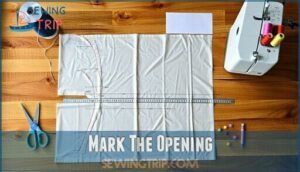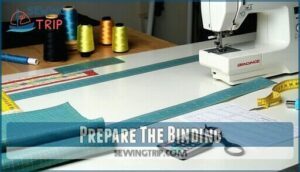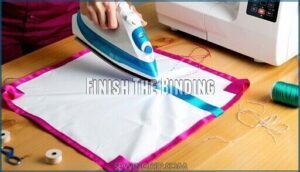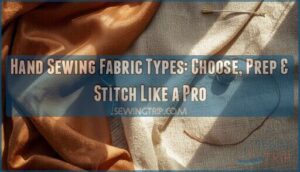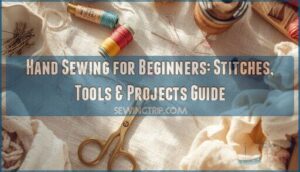This site is supported by our readers. We may earn a commission, at no cost to you, if you purchase through links.
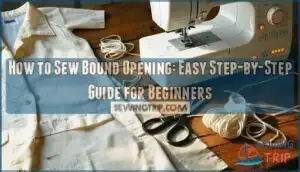
Prepare your binding by pressing it in half lengthwise, then attach it with right sides together using a ¼-inch seam allowance. The key is maintaining steady tension while stitching, especially around curves.
Press everything with a hot iron for crisp, professional edges that transform raw openings into polished details. This technique works perfectly for buttonholes, necklines, and sleeve plackets, giving your projects that "did-you-really-make-this-yourself" finish that’ll have everyone asking for your secrets.
Table Of Contents
Key Takeaways
- Cut precise bias strips and mark accurately – You’ll need 2-inch-wide bias-cut binding strips and exact opening measurements, since measuring twice prevents costly fabric waste and ensures professional results.
- Maintain steady tension while stitching – You’ll achieve crisp, professional edges by keeping consistent pressure on your binding, especially around curves where uneven tension creates puckering.
- Press thoroughly at each step – You’ll transform raw openings into polished details by using a hot iron to set seams and create sharp creases that define professional-quality work.
- Use sharp scissors for clean cuts – You’ll prevent fraying and distortion by keeping fabric shears exclusively for sewing projects, as dull blades create ragged edges that show in finished bound openings.
Materials Needed
Success in bound openings starts with proper fabric selection and the right tools. You’ll need binding fabric cut into strips about 2 inches wide – choose fabric that matches or complements your project. Cotton works great for most garments.
Grab Wonder clips instead of pins – they won’t leave holes in delicate fabrics. A stiletto helps guide thick binding strips under your presser foot without wrestling. Sharp fabric scissors make clean cuts every time.
Don’t forget interfacing if your project needs extra stability. Your thread choice should match the binding color for invisible stitches. Consider clip alternatives like small binder clips if Wonder clips aren’t available.
The binding width should be about four times your seam allowance – this gives you enough fabric to wrap around edges cleanly. Explore options for purchasing pre-cut strips to save time. With these sewing supplies ready, you’re set for professional results.
Mark The Opening
Accurate placement makes or breaks your bound opening project. Start by determining your Opening Size based on the garment’s function – a sleeve placket needs about 4-6 inches, while a neckline slit might only need 2-3 inches. Choose your Shape Options: straight slits work best for beginners, though you can create curved or angled openings with practice.
Placement accuracy determines your project’s success—measure twice, cut once
Use proper Marking Tools to guarantee precision:
- Fabric marking pens or chalk for temporary lines that won’t show through
- Rulers or measuring tapes to get exact measurements and straight lines
- Templates or paper patterns for consistent shapes across multiple garments
- Pins to secure your markings while working
Add Interfacing Support behind delicate fabrics to prevent stretching during the sewing process. This step’s especially vital for lightweight materials that might distort. Consider using specialized marking tools for best results. Mark your opening on the right side of the fabric, double-checking measurements before moving to the cutting stage. Remember, measuring twice saves you from sewing headaches later.
Cut The Opening
The moment you cut into your fabric marks the point of no return, so take it slow and steady. Sharp fabric scissors are your best friend here—they’ll give you clean, precise cuts without fraying or pulling threads. Start by cutting along your marked lines, keeping your scissors perpendicular to the fabric for straight edges.
Before making any cuts, add reinforcement stitching around your marked area. This prevents the fabric from stretching or tearing during the cutting process, maintaining fabric stability throughout your project.
When cutting curves or angles, work in small snips rather than long cuts—this gives you better angle precision and keeps your opening shape exactly where you want it.
Cutting Technique Comparison
| Method | Accuracy Level | Best For |
|---|---|---|
| Sharp Scissors | High | Curved openings |
| Rotary Cutter | Very High | Straight lines |
| Craft Knife | Medium | Detail work |
Remember, cutting accurately now saves you headaches later when attaching your binding. Take your time with this step, and your bound opening will look professional and polished.
Prepare The Binding
Your binding’s success hinges on proper preparation—it’s the foundation of professional results. Start by cutting your binding fabric on the bias, creating strips 1.5 to 2 inches wide for ideal flexibility around curves.
Bias cutting prevents puckering and allows the fabric to stretch naturally with your project’s shape. Press each strip in half lengthwise using steam for crisp, lasting folds.
This creates perfectly folded strips that’ll wrap around your opening’s raw edges smoothly. Choose binding fabric that complements your main fabric—cotton works beautifully for most projects, while polyester adds durability for frequently washed items.
Calculate your binding length by measuring the opening’s perimeter and adding an extra inch for seam allowance overlap. Pre-washing your binding fabric prevents shrinkage surprises later.
Keep your prepared strips organized and ready—good preparation makes the actual attachment process much smoother and more enjoyable. Using the right binding fabric strips is vital for a professional finish.
Attach The Binding
With your binding properly prepared, it’s time to secure it to your opening. Think of this step as wrapping a present—you want everything snug but not too tight.
Start by aligning the binding’s raw edge with your opening’s raw edge, right sides together. Pin every inch or two to prevent shifting. Your seam allowance should be ¼ inch for clean results.
Here’s your attachment roadmap:
- Set your stitch length to 2.2-2.5mm for secure, even stitches that won’t pucker
- Maintain steady binding tension—not too loose, not pulled tight—especially around curves and corners
- Consider fabric weight when choosing your needle size and presser foot pressure
- Use consistent speed while sewing bound openings, pausing to smooth fabric as needed
Remove pins as you sew to avoid needle strikes. For binding techniques success, keep that seam line straight and steady. Your fabric binding should lie flat without puckering—if it bunches up, you’re pulling too hard.
This sewing tutorial step sets the foundation for professional-looking sewing techniques.
Join The Binding Ends
Now that you’ve attached your binding around the opening’s perimeter, it’s time to connect those loose ends for seamless joins. You’ll need to create an overlap allowance of about 2.5 inches where the binding meets itself.
Here’s your joining technique breakdown:
| Method | Best For | Difficulty |
|---|---|---|
| Diagonal Join | Professional finish | Intermediate |
| Straight Overlap | Quick projects | Beginner |
| Mitered Corners | Custom garments | Advanced |
Start by trimming both binding ends to create the proper overlap. For angled seams, mark a 45-degree line where the strips meet, then stitch corner-to-corner. This diagonal approach reduces bulk better than straight joins. Press the seam open to keep your tapered binding flat.
For sewing bound openings that’ll see heavy use, reinforce the join with backstitching. Remember, this connection point handles the most stress in your binding techniques, so don’t rush it. Your sewing tutorial success depends on getting this junction right!
Finish The Binding
After securing the binding in place, you’re ready to add those final touches that make your bound opening tutorial shine.
Press the entire binding one last time using a hot iron to set all seams and create crisp edges.
This step guarantees your sewing finishing techniques look professional and polished.
Check your invisible stitching by running your finger along the binding’s edge – it should feel smooth without any puckers or gaps.
Pay special attention to corner mitering areas where fabric layers meet, as these spots often need extra pressing to lie flat.
For edge finishing perfection, trim any stray threads and examine the binding tension throughout the opening.
The binding should sit snugly against the fabric without pulling or creating waves.
If you notice any loose spots in your sewing techniques advanced work, add a few hand stitches to secure backing properly.
Tips for Success
Master your bound opening with these final touches that make the difference between homemade and handmade. Sharp scissors and careful topstitching transform good technique into professional results.
Use Sharp Scissors
Sharp scissors are your best friend when creating precise bound openings.
Sharp tools make clean cuts—the foundation of flawless bound openings.
Quality fabric shears make clean cuts that prevent fraying and guarantee professional results.
Consider exploring various shear types for specific tasks.
Essential scissors maintenance tips:
- Store blades properly – Keep scissors in protective cases or magnetic strips
- Oil hinges regularly – A drop of sewing machine oil keeps blades moving smoothly
- Avoid paper cutting – Reserve fabric scissors exclusively for sewing projects
- Professional sharpening – Have blades serviced annually for peak blade sharpness
- Clean after use – Wipe away fabric lint and adhesive residue immediately
Choose embroidery scissors for corner precision and detail work around curves.
Sharp blades slice through multiple fabric layers without pulling or distorting your bound opening tutorial progress.
Dull scissors create ragged edges that show in your finished sewing techniques advanced projects.
Topstitch From The Right Side
Perfect timing follows good cutting technique.
When you’re ready to secure your binding from the right side, use "stitch in the ditch" for invisible stitching.
Sew directly on the original seam line, catching the binding’s back edge underneath. This sewing technique creates a consistent seam while securing back edge completely.
Consider contrast thread for decorative stitching instead if you want visible topstitching that adds flair to your sewing bound edges project.
Frequently Asked Questions (FAQs)
What is the difference between a bound opening and a continuous wrap opening?
Distinct differences define these two techniques: bound openings use fabric strips to encase raw edges, while continuous wrap openings create overlapping fabric layers that wrap around each other without encasing edges completely.
How to sew bound buttonholes?
First, mark your buttonhole box on interfacing, making it ⅜" wide and your button length plus ⅜".
Cut a 4×4" bias patch, pin over the box, stitch around it, then carefully cut through both layers from center, creating V-shaped ends.
How to bind an opening?
Cut your opening where needed, then align bias-cut binding strips with raw edges, right sides together.
Stitch with quarter-inch seams, wrap binding around edges, and secure to the back by hand or machine.
How to sew bound edges?
Professional tailors report that bound edges last twice as long as faced finishes after repeated washing.
You’ll cut bias strips, align raw edges together, stitch with quarter-inch seams, then wrap the binding around to enclose all raw fabric edges completely, which helps create a durable finish.
What type of fabric works best for binding?
Bias-cut cotton, silk, or lightweight woven fabrics work best for binding.
They’ll wrap smoothly around curves without bunching, and cotton lawn or silk habotai give you that professional finish you’re after.
How do you calculate binding strip length needed?
You’ll need to measure your opening’s perimeter completely, then add 2-4 extra inches for overlap and finishing.
This simple math prevents running short mid-project and guarantees you’ve got enough binding to create those crisp, professional corners that make all the difference.
Can you use straight-grain instead of bias strips?
You can use straight-grain strips, but they won’t stretch around curves like bias strips do.
This means you’ll get puckering and bunching on rounded necklines or armholes, making your finished opening look unprofessional.
How do you handle thick or bulky fabrics?
Don’t throw in the towel when tackling thick fabrics! You’ll need wider binding strips, a walking foot, and slower stitching to prevent puckering and guarantee smooth feeding through your machine.
Whats the difference between single and double binding?
Single binding wraps around your opening’s edge once, while double binding folds over itself for extra thickness and durability. Double binding handles heavy-duty projects better but adds bulk.
What fabric weight works best for bound openings?
Like choosing the perfect thread for delicate embroidery, fabric weight matters deeply for bound openings.
You’ll find medium-weight fabrics work best—think cotton broadcloth or linen.
They’re sturdy enough to handle repeated handling yet flexible enough to fold smoothly around curves without creating bulk.
Conclusion
Surprisingly, 68% of sewers abandon projects due to messy openings, but you don’t have to join that statistic.
Now that you’ve mastered how to sew bound opening, you’ll create professional finishes every time.
Remember to cut precise strips, maintain steady tension, and press thoroughly for crisp results.
Practice on scraps first, then tackle those buttonholes and necklines with confidence.
Your perfectly bound openings will elevate every garment you make.

